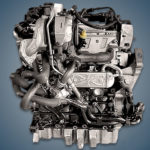The 1.6-liter Volkswagen PN carburetor engine was produced from 1985 to 1992 and was installed on the second generation of the most famous models of the German concern: Golf and Jetta. A similar power unit was installed on the Audi 80 in the B3 body under a different PP index.
The EA827 1.6l series includes: PN, AFT, ADP.
Specifications
| Production years | 1985-1992 |
| Displacement, cc | 1595 |
| Fuel system | carburetor |
| Power output, hp | 69 |
| Torque output, Nm | 118 |
| Cylinder block | cast iron R4 |
| Block head | aluminum 8v |
| Cylinder bore, mm | 81 |
| Piston stroke, mm | 77.4 |
| Compression ratio | 9.0 |
| Features | SOHC |
| Hydraulic lifters | yes |
| Timing drive | belt |
| Phase regulator | no |
| Turbocharging | no |
| Recommended engine oil | 5W-40 |
| Engine oil capacity, liter | 4.0 |
| Fuel type | petrol |
| Euro standards | EURO 1 |
| Fuel consumption, L/100 km (for VW Golf 2 1988) — city — highway — combined |
10.2 6.4 7.7 |
| Engine lifespan, km | ~300 000 |
The engine was installed on:
- Volkswagen Golf 2 (1G) in 1985 – 1992;
- Volkswagen Jetta 2 (1G) in 1985 – 1992.
Disadvantages of the VW PN engine
- This motor is structurally simple and reliable, most of its breakdowns due to age;
- The main engine problems are related to malfunctions of the Pierburg 2EE carburetor;
- Next come failures in the ignition system: candles, distributor, high-voltage wires;
- If you save on oil, then closer to 100,000 km, hydraulic lifters can knock;
- The weak points of the unit include the thermostat and pipes of the cooling system.






